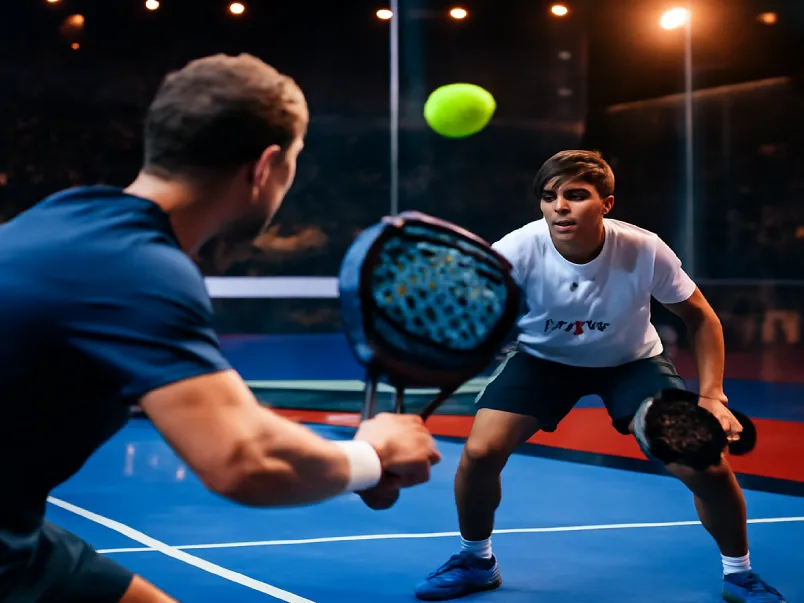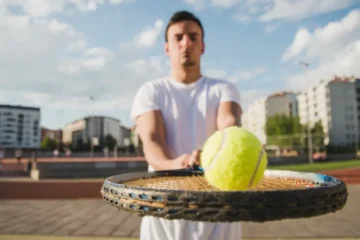Picture this: the sound of a perfectly timed smash echoing through the air, the crack of the ball hitting the glass, and the roar of a packed crowd on the edge of their seats. Padel, a sport that blends tennis and squash, has taken the world by storm, growing exponentially in popularity. What was once a niche game is now the fastest-growing sport globally. Yet, despite its rapid ascent, there remains one major question: Can padel make the leap from a global phenomenon to an Olympic sport?
With its explosive growth and enthusiastic fan base, the case for padel’s inclusion in the Olympics is compelling. However, significant hurdles related to the International Olympic Committee (IOC), governance, global participation, and competition for Olympic spots must be overcome. This article explores the rise of padel, the challenges it faces, and the pathway to potentially seeing it as an Olympic sport.
The Meteoric Rise of Padel – A Case for Inclusion
By the Numbers: The Fastest-Growing Sport in the World
In just over a decade, padel has exploded in popularity, with the number of players growing from 8 million to over 25 million worldwide. This meteoric rise is indicative of the sport’s appeal, which transcends age, skill levels, and geography. Spain is currently the global powerhouse of padel, home to the sport’s most successful players and the largest concentration of courts. However, padel is rapidly spreading across the globe, from the streets of Stockholm to the sands of Dubai and the vibrant cities of North America.
The sport’s growth isn’t just about player numbers. The global expansion of infrastructure, particularly the construction of padel courts, has been a key factor in padel’s success. Major cities are embracing the sport by building state-of-the-art arenas and hosting prestigious tournaments. Media deals and sponsorships have also followed, reflecting the sport’s increasing commercial viability. These developments are a strong case for padel’s inclusion in the Olympics, but they are only part of the story.
The “Why”: Padel’s Winning Formula
Padel’s rapid success can be attributed to several factors that make it appealing to players and spectators alike. First, padel is highly accessible. It’s easier to pick up than tennis, requiring less physical stamina, making it an ideal sport for people of all ages and fitness levels. The emphasis on doubles play also creates a social, team-oriented environment that appeals to casual players.
Spectator appeal is another significant factor. Padel is fast-paced, highly strategic, and easy to watch. The sport’s unique glass-walled courts bring fans closer to the action, creating an intimate, TV-friendly viewing experience. Unlike tennis, which can feel like a marathon, padel matches are shorter, making them more digestible for both in-person and TV audiences.
Moreover, padel fits the urban and time-conscious lifestyles of the modern world. The sport is often played in cities, with short, quick matches that don’t require a full day commitment. It’s a perfect fit for busy, younger generations seeking fun and engaging activities that don’t necessarily require an entire afternoon.
The Golden Ticket: How a Sport Becomes Olympic
To understand how padel can make its way into the Olympic Games, it’s essential to first grasp the criteria that the IOC uses to assess potential new sports.
The IOC’s Playbook: Meeting the Official Criteria
For any sport to be considered for the Olympics, it must meet a strict set of criteria established by the IOC. One of the most important is governance. A sport must have an international governing body that is recognized by the IOC. In the case of padel, that governing body is the International Padel Federation (FIP), which works in tandem with the IOC to promote the sport globally. However, there is an ongoing relationship with professional tours like Premier Padel, which could complicate the IOC’s assessment of padel’s unified governance structure.
Another requirement for Olympic inclusion is global reach. For a sport to be considered for the Games, it must be practiced by both men and women in multiple continents. Padel is already well-established in Europe, South America, and increasingly in the Middle East and North America, but its presence in Asia and Africa remains limited. While the sport has expanded rapidly, these two continents represent a significant gap in its global appeal.
The sport must also comply with the World Anti-Doping Agency (WADA) code, ensuring that it adheres to anti-doping regulations. This is an area where padel has been proactive, ensuring that it meets IOC standards for fairness and integrity.
The Unwritten Rules: The Real-World Hurdles
Beyond these formal criteria, there are unwritten challenges that any sport must navigate to gain Olympic status. One of the most significant is the “one-in, one-out” mentality that governs the Olympic program. The IOC has a fixed number of spots for events, so adding a new sport often requires removing an existing one. This creates a tough political environment where new sports must not only prove their worth but also compete against long-standing events for a coveted place in the Games.
Moreover, the IOC has a strong desire to appeal to younger audiences. In recent years, the inclusion of sports like skateboarding, surfing, and sport climbing has reflected this trend toward more urban, youth-oriented sports. Padel’s dynamic, fast-paced nature and strong appeal to younger players and spectators make it a great fit for the IOC’s current strategy.
Finally, the financial side of the Olympics cannot be ignored. The IOC is looking for sports that can generate substantial ticket sales, TV ratings, and sponsorship revenue. Padel’s commercial viability, particularly with its growing media presence, could make it an attractive prospect for the IOC.
The Pro-Padel Argument: Why the IOC Might Say “Yes”
So why might the IOC say “yes” to padel? Several key factors work in the sport’s favor.
A Perfect Fit for the “New” Olympics
Padel’s alignment with the IOC’s Agenda 2020+5 makes it an ideal candidate for Olympic inclusion. The IOC has emphasized gender equality, youth appeal, and urban sports in its vision for the future. Padel’s popularity among both men and women, its appeal to younger audiences, and its urban nature make it a perfect fit for the evolving Olympic program.
Medal Certainty for Key Nations
Another attractive feature of padel is its strong performance in certain countries. Spain, Argentina, and Brazil are powerhouses in the sport, with a high level of competition and numerous world-class players. The presence of dominant countries like these makes the sport appealing to both host nations and broadcasting markets, ensuring a competitive and engaging event that can draw in viewers.
Compact and Cost-Effective
Padel courts are small and compact, meaning they can be set up in temporary venues or urban environments. This makes it much easier and more cost-effective to integrate padel into the Olympics, particularly when compared to other sports that require large, expensive infrastructure. Like beach volleyball, which has thrived in temporary Olympic venues, padel could be showcased in iconic urban locations, providing a visually stunning and cost-effective event.
The Roadblocks: Why the Dream Might Be Deferred
Despite the compelling case for padel, there are significant obstacles that could delay its Olympic dream.
The Dominance Dilemma
While padel is growing rapidly, its dominance remains concentrated in Spain, Argentina, and a few European countries. The lack of widespread participation in Asia and Africa remains a major hurdle for the IOC, which requires global reach to consider a sport for inclusion. Padel must continue to grow in these regions and establish a truly global presence to meet the IOC’s requirements.
The Governance Hurdle
The governance of padel is another potential stumbling block. The FIP, which oversees the sport, must navigate its complex relationship with professional tours like Premier Padel and others. The IOC prefers to see unity in a sport’s governance, and any signs of division or infighting could deter them from offering Olympic status.
Stiff Competition
Padel is not the only sport vying for a spot in the Olympics. It competes with other sports like squash, flag football, and cricket (which will return in 2028) for a limited number of spots. The competition for these spots is fierce, and the IOC’s decision-making process can often be unpredictable.
The Pathway to the Podium: What Needs to Happen Next?
For padel to reach the Olympics, several key milestones must be achieved.
Short-Term Goal: Multi-Sport Games
Before it can make it to the Olympics, padel must prove itself in other multi-sport events. Success in the Pan American Games, Asian Games, and European Championships would demonstrate that padel is ready for the global stage. These events provide a testing ground for the sport, helping it gain recognition and experience on the international level.
The 2032 Brisbane Games: A Realistic Target?
Many believe that the 2032 Olympics in Brisbane, Australia, could be the perfect opportunity for padel to break through. The IOC’s Pacific strategy, combined with the growing popularity of padel in the region, makes it an ideal fit. The next few years will be crucial in determining if padel can grow its global presence and unite its governing bodies to make a compelling case for Olympic inclusion.
The Unification Imperative
A unified front from the FIP, professional players, and tour organizers is essential for the IOC to take padel seriously. If the sport’s governing body can overcome internal divisions and present a cohesive, organized structure, it will increase its chances of success.
Conclusion: Not If, But When?
Padel is already a global phenomenon, with an ever-growing player base and strong commercial backing. While the road to the Olympics is filled with challenges, it’s not a question of “if” but rather “when.” The sport’s explosive growth, youth appeal, and international potential make its eventual inclusion in the Games a realistic goal. The 2028 Olympics may come too soon, but with the right steps in place, the world may soon witness the first Olympic padel gold medal match.
FAQs (Frequently Asked Questions)
1. What is padel, and how is it played?
Padel is a fast-paced racket sport that combines elements of tennis and squash. Played on a smaller court with glass walls, padel is typically played in doubles format. The game is similar to tennis but uses solid rackets and a slower ball, allowing for longer rallies and more strategic gameplay.
2. Why is padel growing so fast?
Padel’s rapid growth can be attributed to its accessibility, social nature, and urban appeal. The sport is easy to learn, less physically demanding than tennis, and is often played in doubles, making it perfect for socializing. The compact nature of the courts also makes it suitable for cities, where space is limited.
3. Is padel an Olympic sport?
Currently, padel is not an Olympic sport, but it is gaining momentum in its quest for inclusion in future Games. The International Padel Federation (FIP) is working to meet the requirements set by the International Olympic Committee (IOC), but challenges related to governance, global participation, and competition for Olympic spots remain.
4. How can padel become an Olympic sport?
For padel to become an Olympic sport, it must meet several criteria set by the IOC, including global reach, gender equality, anti-doping adherence, and strong governance. Padel also needs to prove its appeal to a global audience and demonstrate its commercial viability in the Olympics.
5. When could padel make its Olympic debut?
While there is no official timeline, the 2032 Brisbane Olympics is considered a potential target for padel’s Olympic debut. Padel must continue to expand globally and unify its governing bodies before it can make a successful bid for the Games.
6. Which countries dominate in padel?
Spain is the world leader in padel, followed by Argentina, Brazil, and several European countries. While the sport is growing in North America and the Middle East, its presence in Asia and Africa remains limited, which presents a challenge for its global recognition.
7. What are the benefits of playing padel?
Padel offers several benefits, including physical fitness, social interaction, and stress relief. It is an excellent cardiovascular workout that improves agility, coordination, and strength, while also being a fun and low-impact sport for players of all ages.




